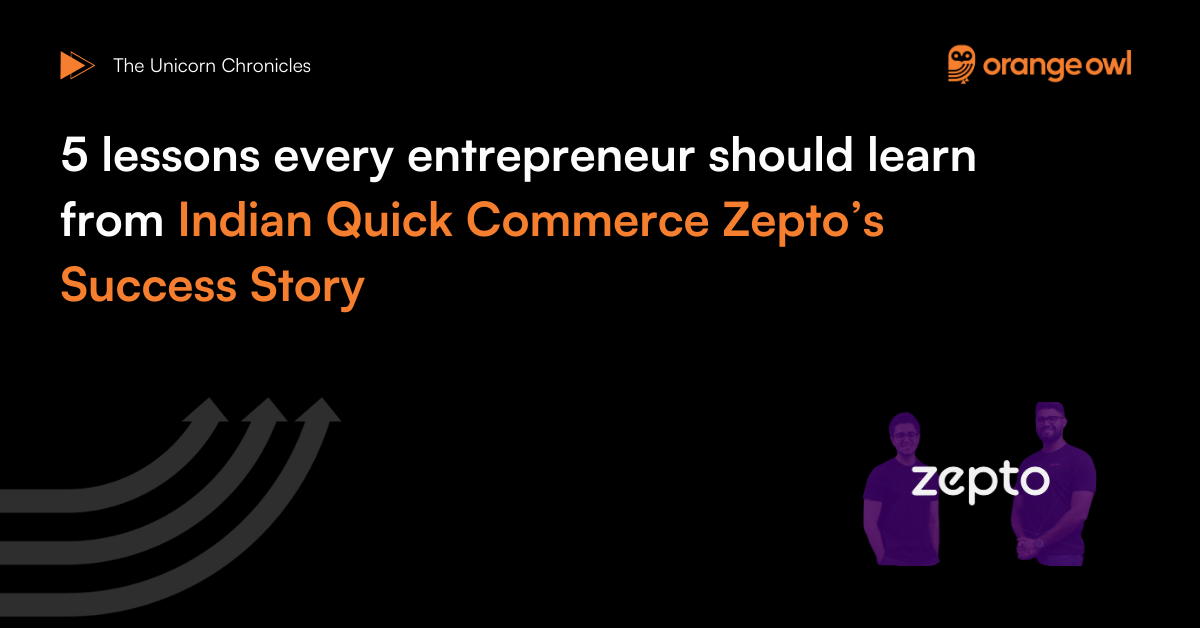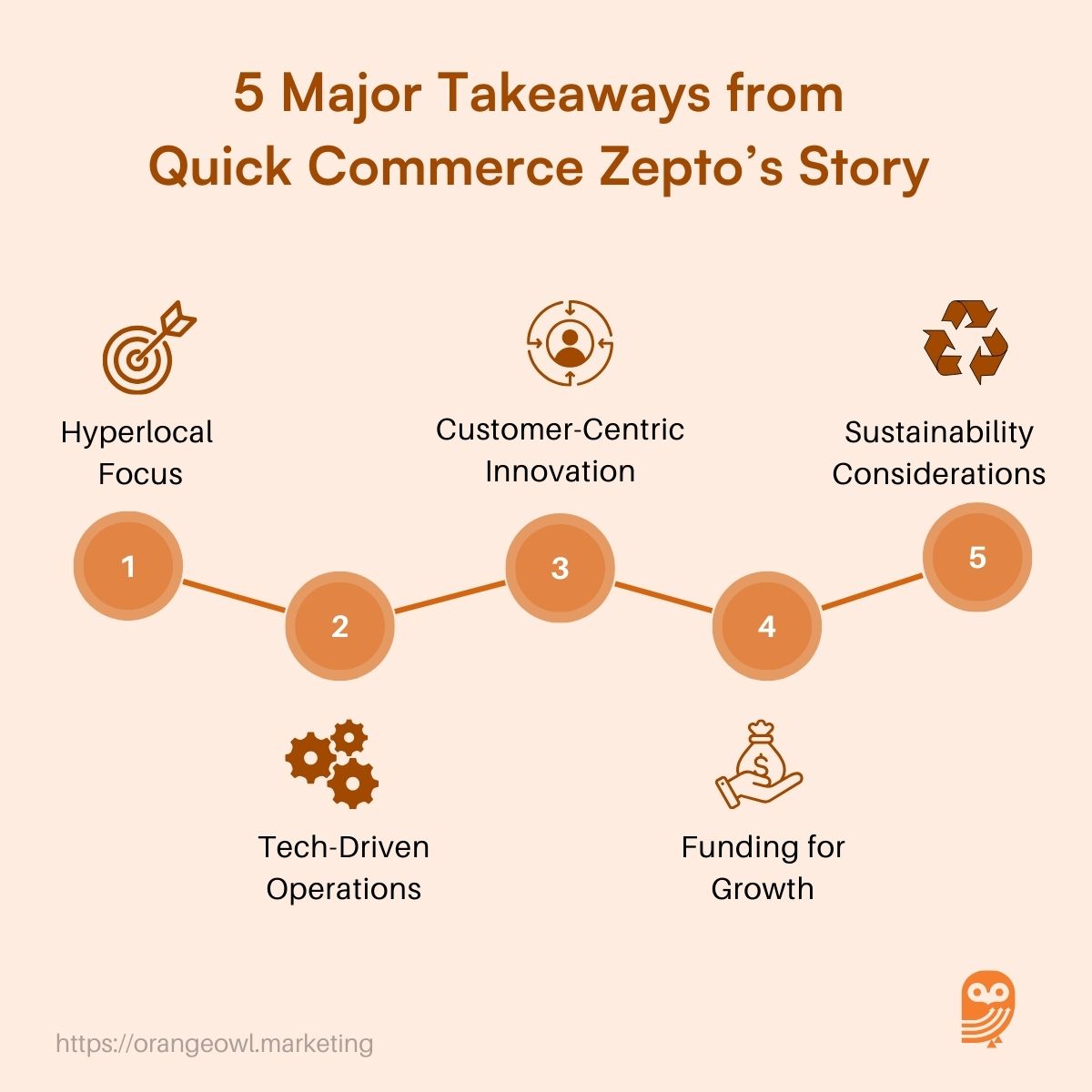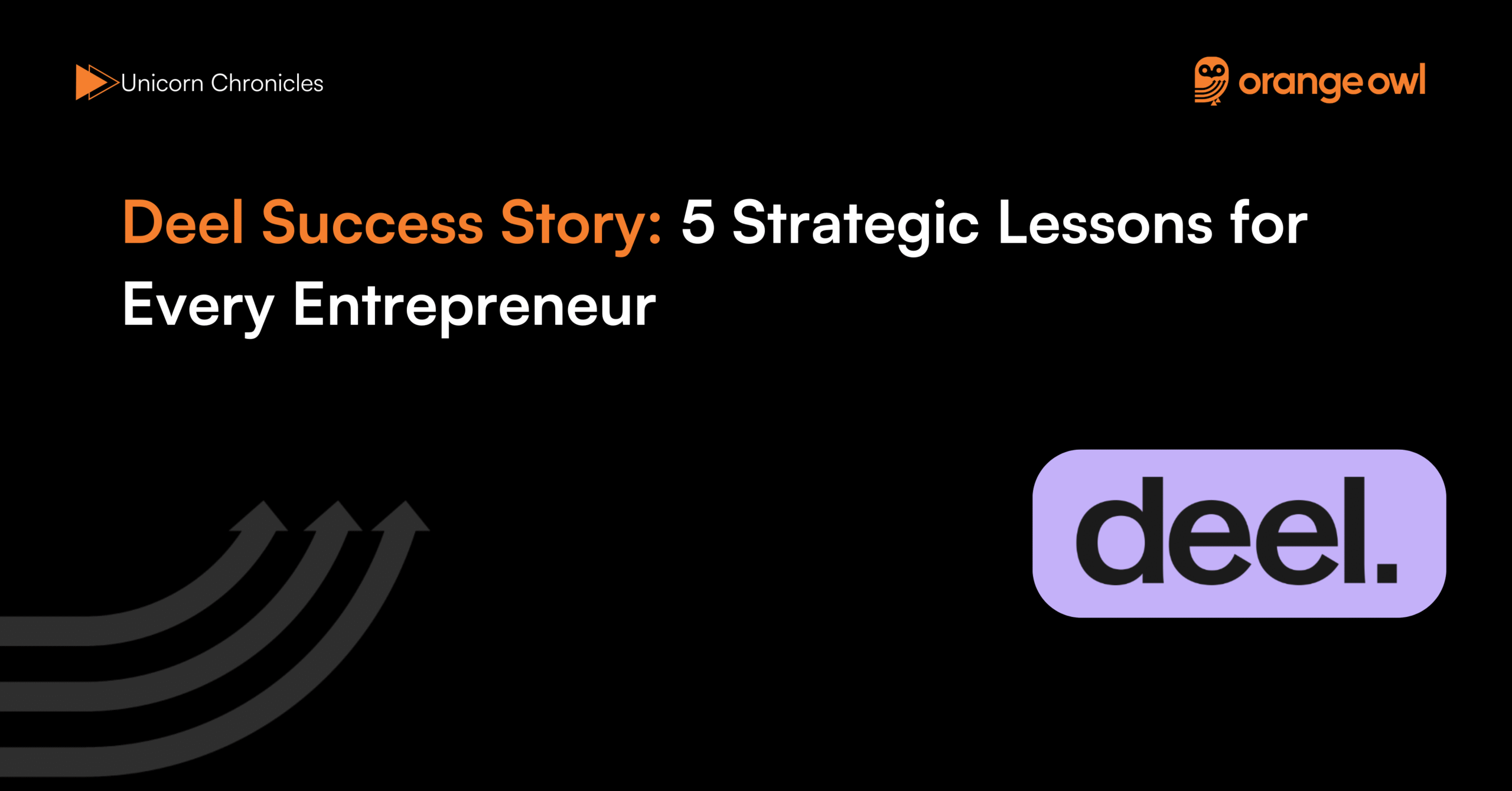5 Key Lessons Every Entrepreneur should learn from the Zepto Success Story
Vivek Goel
February 10, 2025

Table of Contents
Introduction
Launched in 2021 by young entrepreneurs Aadit Palicha and Kaivalya Vohra, Indian Quick Commerce Zepto success story has quickly disrupted India’s grocery delivery sector with its unique 10-minute delivery promise. Headquartered in Mumbai, Zepto targets urban millennials and Gen Z consumers, offering convenience and speed for everyday grocery shopping.
In a market crowded with established players like BigBasket and Swiggy Instamart, Zepto’s bold approach has set it apart, propelling it to rapid growth and making it a name to watch in the quick commerce space.
Stanford University dropouts, Aadit Palicha and Kaivalya Vohra left their computer science studies to dive into the startup ecosystem during the pandemic.
As Vohra puts it, “The reason why we pushed so hard is that we had so much conviction about the product. We believed the product will be exciting and change the way people are buying groceries today.”
This conviction led them to identified a gap in the online grocery delivery market: while other companies were offering deliveries within hours or days, no one was catering to the immediate needs of busy urban professionals and young consumers who wanted groceries delivered fast. This insight led to the creation of the Zepto success story , a brand dedicated to ultra-fast grocery delivery.
Reflecting on the journey, Aadit Palicha, a serial entrepreneur, highlighted the learning process, saying, “We learned more from our failures than our successes. Every misstep taught us something critical, which we applied to make Zepto a success.” This mindset of embracing challenges and applying lessons has been key to Zepto’s rise in the quick commerce sector.
Aadit Palicha, brought in his experience from previous ventures to Zepto, focusing on customer behavior and demand patterns. Kaivalya Vohra, with his deep technical expertise, spearheaded the development of the Quick Commerce Zepto’s tech-driven backend, ensuring smooth and efficient logistics to meet their 10-minute promise. Their complementary skill sets have been pivotal in shaping Zepto’s strategy and execution.
Unique Strategies and Growth Model of the Quick Commerce Zepto Success Story
Indian Quick Commerce Zepto standout strategy is its hyperlocal dark store model, where small warehouses are strategically located in neighborhoods to serve customers within a 2-3 km radius. This model enables Zepto to keep delivery times short and operational costs low, as the warehouses only stock high-demand items. The company leverages data analytics to optimize inventory, predicting consumer needs and stocking their dark stores accordingly.
A significant contributor to the success of Zepto’s dark store model is their PPB (Picking, Packing, Bagging) formula:
Picking – A streamlined process in all Zepto stores, where employees are equipped with tablets. When an order is placed, it gets routed to a central hub before reaching the dark store. The system guides employees by displaying which items are needed and their exact location on the shelves, accelerating the picking process.
Packing – Once the items are picked, they are quickly collected and packed for delivery. This step is optimized to minimize time spent on handling and preparing items.
Bagging – As soon as a delivery agent arrives to collect the order, the final step is bagging. Zepto mandates a strict 60-second timeframe for all three procedures—choosing, packaging, and bagging—to ensure the delivery speed that they promise to their customers.
Focus on Delivery Partners
Quick Commerce Zepto places a strong emphasis on the welfare of its 50,000+ delivery partners, offering benefits such as insurance, healthcare, and vehicle maintenance support. This approach has helped the company maintain high employee satisfaction and low churn, which are critical for sustainable growth in the gig economy. By investing in the well-being of their delivery partners, Zepto ensures reliable and motivated riders who are key to fulfilling their 10-minute delivery promise.
Marketing has also been a key lever in Zepto’s growth, with the brand targeting the younger demographic through digital platforms, influencer collaborations, and social media engagement. Zepto’s emphasis on a simple, intuitive app interface appeals to tech-savvy users who value efficiency and ease of use. Their focus on creating a user-friendly experience has helped them build a loyal customer base and achieve high retention rates in a short span of time.
Quick Commerce Zepto has also invested heavily in technology, developing proprietary logistics software that enables real-time order tracking, delivery route optimization, and inventory management. These systems have allowed them to scale quickly, despite the complexity of their ultra-fast delivery promise. By harnessing machine learning algorithms, Zepto continuously refines its delivery routes, ensuring the quickest possible delivery times while minimizing logistical costs.
Scaling Up and Competitive Edge in zepto’s Success Story
Zepto’s scaling journey has been rapid and effective. Unlike traditional grocery delivery models, Zepto focuses on speed without compromising quality. It has raised substantial funding from investors like Y Combinator, Nexus Venture Partners, and Glade Brook Capital, which has fueled its aggressive expansion into major Indian cities like Bangalore, Delhi, Mumbai, and Hyderabad.
The startup’s growth strategy revolves around localized expansion—opening clusters of dark stores in a new city simultaneously, ensuring that they can meet delivery expectations from day one. This localized cluster strategy has enabled them to build a dense delivery network, keeping customer acquisition costs low while enhancing delivery speed.
Zepto differentiates itself from competitors by sticking firmly to its 10-minute delivery promise. While giants like BigBasket and Amazon Fresh focus on extensive inventory and next-day deliveries, Zepto’s approach is based on curated selections of fast-moving goods, ensuring they have what the consumer needs most urgently. Their fleet of delivery riders managed efficiently through tech-driven platforms, allows them to execute their promise in highly congested urban environments.
What makes Quick Commerce Zepto different from others?
Quick Commerce Zepto differentiates itself from Swiggy Instamart and Blinkit primarily through its unique focus on ultra-fast delivery and the Cash on Delivery (COD) payment option. While both Swiggy Instamart and Blinkit also offer grocery and essential deliveries, Zepto sets itself apart with its promise of delivering items in just 10 minutes, targeting customers who need instant deliveries.
In contrast, Swiggy Instamart offers a broader range of services, including food, groceries, and even pick-up/drop-off through Swiggy Genie, making it a more versatile platform. Blinkit, which also specializes in grocery delivery, benefits from its integration with Zomato, expanding its reach by tapping into Zomato’s established food delivery infrastructure.
Therefore, Zepto’s emphasis on speed and COD payment positions it as the go-to service for quick, hassle-free grocery deliveries, while Swiggy and Blinkit cater to a wider range of consumer needs through their comprehensive service offerings.
Challenges and Overcoming Obstacles
Operating in the quick commerce sector is not without its challenges. Delivery speed demands robust logistics, and any disruption—like traffic congestion or inventory mismanagement—could impact their brand promise. Zepto has addressed this by constantly fine-tuning their dark store locations and enhancing predictive analytics for inventory management.
Another challenge has been the sustainability of ultra-fast deliveries. Critics have raised concerns about the environmental impact of rapid deliveries, but Zepto has been working on mitigating this through carbon offset programs and exploring electric vehicle delivery options. Additionally, they focus on driver safety, making sure delivery times don’t lead to reckless driving by carefully monitoring rider behavior.
Regulatory hurdles and competition are also pressing concerns. While traditional grocery delivery services may not match Zepto’s speed, they have a strong market presence. Zepto’s strategy of high-density dark stores, coupled with its user-centric app design, has allowed it to carve out a niche in the crowded market, catering specifically to those who prioritize speed and convenience.
5 Lessons for Entrepreneurs: What Makes Zepto Stand Out from its Success Story
1. Hyperlocal Focus
Zepto’s use of a dark store model to cover small neighborhoods allows it to maintain a quick delivery promise while keeping logistics manageable. Entrepreneurs can learn the value of targeting niche markets and mastering them before scaling up.
Takeaway: Focus on a specific, well-defined market segment and master it before scaling. By catering to a targeted audience, you can fine-tune your operations, optimize resources, and build a strong brand presence before expanding to a larger market.
Example: A local coffee shop starts by focusing solely on high-quality, specialty coffee for a small neighborhood of young professionals and students. They tailor their menu, ambiance, and marketing specifically to this group. Once they’ve established a loyal customer base and perfected their operations, they can consider expanding to other neighborhoods with similar demographics, ensuring the quality and experience remain consistent.
2. Tech-Driven Operations
By leveraging data analytics and machine learning, Zepto efficiently manages inventory, delivery routes, and customer expectations. Investing in technology to streamline operations can give startups a competitive edge in crowded markets.
Takeaway: Investing in technology to streamline operations, from inventory management to customer service, can help entrepreneurs optimize efficiency, reduce costs, and gain a competitive edge in a crowded market.
Example: A fashion e-commerce startup uses machine learning algorithms to predict which products will be in demand based on customer behavior and trends. By integrating this data into their inventory system, they reduce overstock and stockouts, ensuring fast and accurate order fulfillment. This tech-driven approach not only improves operational efficiency but also enhances the customer experience by offering the right products at the right time.

3. Customer-Centric Innovation
Zepto’s 10-minute delivery promise isn’t just a marketing gimmick; it addresses a real consumer pain point in urban areas. Entrepreneurs should focus on understanding their customers’ needs deeply and deliver solutions that offer true value.
Takeaway: Understanding your customers’ pain points and delivering solutions that provide real value is key to building lasting customer loyalty and a strong brand reputation.
Example: A startup in the fitness industry notices that many people struggle with finding time for workouts due to busy schedules. In response, they create a flexible, on-demand virtual workout platform, allowing users to access live or pre-recorded sessions at their convenience. By addressing the real pain point of time constraints, the startup attracts a loyal customer base, offering a solution that fits into their daily lives seamlessly.
4. Funding for Growth
Zepto’s successful funding rounds have allowed it to scale rapidly and outpace competitors. Having a solid, scalable business model can attract investors who believe in your vision.
Takeaway: A solid, scalable business model is essential for attracting investors. Demonstrating potential for growth and a clear vision can secure the necessary funding to scale your business and outpace competitors.
Example: A SaaS startup develops a subscription-based platform for small businesses to manage their social media accounts. With a proven product and clear plans for expanding features, they attract investors who see the potential to scale. The startup uses this funding to enhance their platform, improve user acquisition, and expand into new markets, ultimately growing faster than competitors with less clarity on their scalability.
5. Sustainability Considerations
As Quick Commerce Zepto grows, it continues to explore sustainable delivery options. In today’s market, a focus on sustainability is not just good PR; it’s becoming a consumer expectation.
Takeaway: Sustainability is not just a trend but a growing consumer expectation. Entrepreneurs should integrate eco-friendly practices into their business model, as it can enhance brand image and attract conscious consumers.
Example: A clothing brand adopts sustainable sourcing and uses eco-friendly packaging. They also offer customers a discount for recycling old garments. By aligning with consumers’ increasing demand for sustainability, the brand attracts eco-conscious shoppers, boosts customer loyalty, and differentiates itself in a competitive market.
Conclusion
Zepto’s trajectory suggests it’s on track to become a dominant player in India’s quick commerce space. As it continues to scale, expect the company to experiment with product diversification, expanding beyond groceries to include pharmaceuticals, personal care items, and more. With ongoing investment in technology and potential partnerships with local suppliers, Zepto aims to continue redefining convenience shopping for India’s urban population.
In just a short period, Zepto has shown how understanding market gaps, leveraging technology, and committing to a clear vision can lead to remarkable success in a highly competitive market.


